Victoria Sadler's Blog, page 22
January 25, 2014
Theatre Review: Blurred Lines, National Theatre
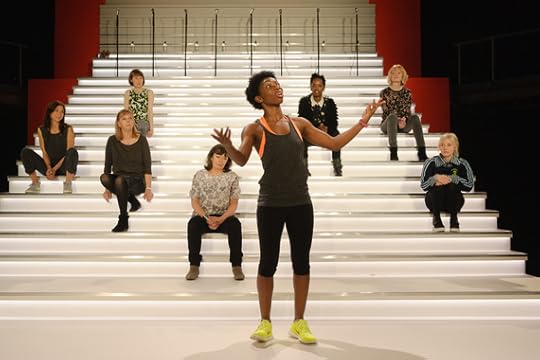
The title of the play gives it away. Blurred Lines at The Shed is a sharp, punchy look at gender politics in Britain today. It's a bright, exciting production that combines spoken word and music, but its claim to "dissect what it means to be a woman today" is highly questionable.
Set against a stunning set from Bunnie Christie, a large bright white staircase that flashes up in neon colours, the eight women that make up the cast run through the very tightly written series of playlets.
Playing a myriad of characters, all the women on the stage give superb performances. And the direction and writing are both so sharp that the little scenes flow together so seamlessly, like a river, that there's no let-up in the strong pace of the show.
But it's the content of that stream that concerns me. The playlets all reflect the challenges women face in society - the impact of pornography, rape, cheating husbands, discrimination at work, competition from other women, exploitation in the media, sexual objectification in the press...
That these are genuine challenges I do not for one second deny but every single character in this play is a victim. Every single one. Without exception. Not one strong confident female character to be seen or heard at all. That's a pitiful representation of women today and one that not only misrepresents women but ironically perpetuates one of the core issues in the Robin Thicke video that it so rightly claims to admonish.
It's also impossible to overlook the fact that this play was written by a man. That's right. A feminist play written by a man. Actually I think that pretty much sums up the challenge for women today right there.
Admittedly this is a very talented man indeed. Nick Payne was the writer of Constellations, the innovative award-winning play that was widely considered the best show of 2012. But why wasn't a female playwright asked to write this?
If this were a play that proposed to dissect what it means to be a black man but it was written by a white man, or a play that said it would dissect what it means to be a gay man today but was written by a straight one, there'd be uproar. And rightly so.
I mean, just how hard does it have to be for female playwrights? Just to be clear, this isn't about whether men can be feminists. Of course they can. In fact the very success of feminism depends on male support but it's about the appropriation of the subject matter away from women even before they've had a chance to express it for themselves.
But the National has previous in this area. In the wonderful NT50 anniversary show that was televised last November only one show in the production was written by a female playwright. One - Alecky Blythe's brilliant London Road. Stoppard, Bennett, Hare, they all got multiple mentions in one show but women? Just one for the whole gender.
This choice of male writer may have contributed to some of the more questionable political points in the show. At one point, when a mother realises she is being pushed out of her advertising job because of her family commitments, she takes off her high heels and throws them down the staircase to replace them with trainers. Right. So are we to read from this that women who like wearing heels are letting down the side? Oh please.
It's that whole 'good' feminists/'bad' feminists debate.
Lady Gaga's song Do What U Want is sung as a representation of women demeaning themselves for men. Setting aside this misrepresentation of the lyric (when Gaga sings "Do what you want with my body" she's actually gunning at the media for their pointed jabs at the way she presents herself physically) why can't Gaga be sexually promiscuous or, more pointedly, submissive? Why can't women? The inference that women who choose that for themselves somehow let the side down is a nasty message and one that I am not comfortable with at all.
Blurred Lines makes many valid points and is a very though-provoking piece. Women undeniably face real challenges in British society today. But this play does not fully dissect what it is to be a woman today. We are not all victims.
The Shed, National Theatre, London
To February 22, 2014
Published on January 25, 2014 04:48
January 23, 2014
Theatre Review: Rapture, Blister, Burn, Hampstead Theatre
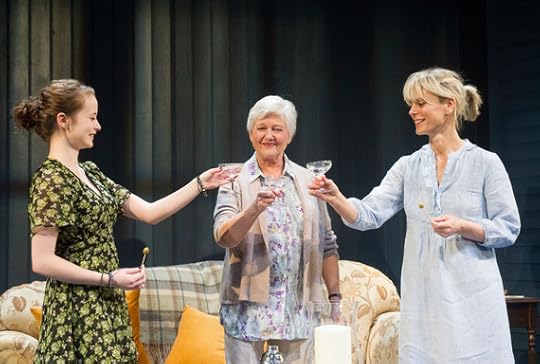
Not all theatre can be challenging and innovative. Certainly Rapture, Blister, Burn - a play about gender politics - is neither of these but there is plenty to enjoy in this charming comedy.
Rapture, Blister, Burn is written by Gina Gionfriddo, the talented writer of Becky Shaw which ran at the Almeida in 2011. Set in the United States, the story follows Catherine (Emilia Fox), a high-achieving alpha-female, who returns from New York to her small hometown when her mother Alice (Polly Evans) falls sick.
Her mother's mortality causes Catherine to question where she is in life, and to consider whether choosing not to settle down with her old ex-boyfriend was a missed opportunity. Only that ex-boyfriend, Don (Adam James), now lives just down the road from her mother. And he's married with kids to one of Catherine's childhood friends, Gwen (Emma Fielding).
But Catherine isn't the only one with doubts. Gwen isn't happy either. Yes, she has the husband and the kids but now she spends all her time whether she missed out on life. Did having a family deny her the opportunity to live her dreams, just as Catherine has done?
So as Catherine and Gwen rekindle their friendship, and as Catherine secretly rekindles her passion with Don, the idea of swapping lives goes from a joke between the two women to a real possibility.
Catherine teaching a class on feminism to Gwen and her wayward young babysitter, Avery (Shannon Tarbet) is the loose framework which provides the opportunity for Gina Gionfriddo to run us through the battleground of gender politics. There are plenty of references to Phyllis Schlafly, Betty Friedan, Roe vs. Wade and the Equal Rights Amendment. In fact so much so that you often feel you're being educated in a lecture hall rather than entertained in a theatre.
However Gionfriddo's sharp wit is in plentiful supply which prevents the piece becoming too dry. The best and more barbed comments are saved for Avery, a smart confident young woman who's as inspired by Catherine's stellar career as she is dismissive of Gwen's housewife existence, as evidenced by her quip "I've thought about being a stay-at-home mum, just as a fuck you to the system."
In fact it is Shannon Tarbet as Avery who gives the stand-out performance in the show. Her composure is remarkable as is her deadpan delivery of her lines. She made a phenomenal impact and is clearly a very talented actor.
Emilia Fox though disappoints as Catherine. Fox's performance seemed nervous throughout and she didn't bring much depth or variety to her role as the career woman with regrets. Her portrayal was quite one-dimensional, making the lead character a bit of a cliché.
Emma Fielding and Adam James had greater success in bringing colour and truth to their portrayal of the unhappily married couple and brought to life what could have been a stereotypical situation and relationship.
Polly Adams gives a heart-warming and engaging performance as Catherine's mischievous mother. Her joviality is practically palpable. Her American accent did go AWOL at times though. I would quite happily have her ditch it completely and just deliver her lines in her British accent as the slipping in and out of the accent is noticeable.
The conclusion of the play is upbeat, of course. However the central message of the play, that a woman is fine with or without a man, would have been outdated in the 1980s, let alone in the 21st century. Gender politics has moved on to far more challenging issues than this. Rapture, Blister, Burn therefore isn't anything new or ground-breaking, but it is an enjoyable evening nevertheless.
Hampstead Theatre, London
To February 22, 2014
Published on January 23, 2014 13:33
January 22, 2014
Theatre Review: The Weir, Wyndham's Theatre

This production of The Weir is so warm and intimate, it makes you feel as if you've just pulled up a bar stool in a rural Irish pub for the evening.
The premise of this play is a simple one. The four men at a small pub in rural Ireland, more a converted outhouse, are excited by the arrival of a stranger. This stranger, a woman from Dublin, is coming to their pub for a drink.
Each of the men is determined to impress her with their stories, local legends and fanciful tales. But lost in the need to impress the woman in their midst, they end up revealing more about themselves than they ever intended.
This may seem a low-stakes story on the surface but this is a very well-crafted play. On its première in 1997, The Weir won the Evening Standard, Critics' Circle and Olivier Awards for Best New Play. And well-deserved too as Conor McPherson captures rural Ireland beautifully in style, attitude and language. His writing balances real wit with genuinely poignant moments.
This production of The Weir, its first major British revival, originally ran at the Donmar last Spring where it was hugely popular. The intimacy of the Donmar was a perfect setting for this play but little of that closeness and warmth has been lost in the transfer to the Wyndham's.
Josie Rourke's direction really brings out the best in the play, giving actors the space to develop their characters with idiosyncrasies, and allowing the tedium of spending an evening in a pub to be reflected in the prolonged silences. The pacing of the play shows a brave, deft touch and the risk of letting moments of reflection hang gives the production a lot of truth.
And she is supported by a terrific cast of five, all of whom were in the version shown at the Donmar.
Most will, of course, recognise Brian Cox who plays Jack, the aging single man whose big character dominates the pub for good and for ill. As ever, his performance is superb. Ardal O'Hanlon is also a familiar face from his comedy stand-up and Father Ted and his portrayal of Jim, a loner ill at ease in the company of strangers is beautifully done.
Dervla Kirwan is almost a household name for her time in Ballykissangel and she is perfect as Valerie, the woman from the big city enchanted by the village but as much running away from something as she is running towards the peace and quiet.
Finbar, the man most determined to impress Valerie, is played perfectly by Risteárd Cooper. Very much the wide-boy of the village with his white suit and wilful flaunting of his comparative wealth, Cooper ensures his Finbar has enough depth to balance out the comic touches.
Peter McDonald plays Brendan, the single middle-aged man who runs the pub, and he gives a perfectly understated performance as a man just trying to get on with life without getting caught up between the strong characters that dominate his pub and, seemingly, his life.
If you like your theatre as THEATRE - big productions with plenty of effects and shocks - then The Weir is not for you. No character is profoundly changed by the end - each leaves much the way they came in. Nor is it clear if anything's been learnt or resolved.
Instead The Weir is all about moments in time, small revelations on incidents in life, incidents that have come and gone. Often these types of plays can lack narrative drive, audiences dozing off before the end, but not in this instance. I found The Weir to be tender and truthful and utterly captivating.
Wyndham's Theatre, London
To April 19, 2014
Published on January 22, 2014 14:56
January 18, 2014
Ballet Review: Le Corsaire, English National Ballet
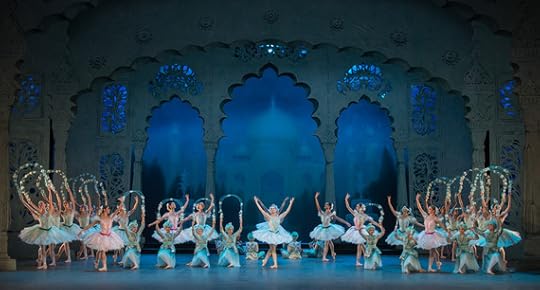
Le Corsaire (the pirate) is a bright, upbeat ballet, unlike the more popular but tragic ballets such as Swan Lake, Giselle and Romeo and Juliet. And this version of this rarely performed piece of work is packed full of talent and energy.
Its premise is simple. Conrad, the pirate, sets out across the seas to the Ottoman Empire to rescue his love, Medora, from the clutches of the slave trader who wants to sell her on to Pasha, a wealthy Seyd.
The performance I saw had Tamara Rojo, the Artistic Director of the English National Ballet and one of the most famous ballerinas of her generation performing as Medora. Though (whisper it quietly) she will be 40 this year, her performance, her technical excellence remain an honour and privilege to watch.
And she has such personality as well as such talent. Rojo's Medora was bright, captivating, a teasing presence on the stage as she played and mocked Pasha, the wealthy man holding her captive.
The exquisite Tamara Rojo is obviously a massive box-office draw. But though the crowds will turn up to see this star, they will also witness the birth of another.
Junor Souza, a young dancer from Brazil, performed as Ali, Conrad's devoted slave. The ballet demands a lot from its male performers but Souza's performance was breath-taking. His leaps were athletic but graceful. His performance was full of such verve, such presence, that the audience was cheering from halfway through his solo performances.
Though few of us knew his name at the start of the show, it was on everyone's lips at the close. At the curtain call, the cheers for Souza were as loud as those for Rojo. He is unequivocally a star on the rise.
Conrad was performed by the brilliant and dashing Matthew Golding, perfect casting as the hero of the tale. His performance too was energetic and bold. It really was a feast of talent on the stage. As Artistic Director, Rojo has drawn so much talent to the English National Ballet. And the talent is not confined to the performers.
The sets and costumes were designed by Bob Ringwood, a Hollywood veteran from Batman, Empire of the Sun and the Alien films. The costumes dazzle in texture and variety - embellished tutus, jewelled harems pants and feathered headpieces. And the sets are imbued with the feel of the Orient with bustling bazaars and ornate palaces.
However the production is not without risk. Issues of historic sexual harassment dominate the headlines at the moment, with Rolf Harris and Dave Lee Travis currently in focus. That does make the portrayal of Pasha as a dirty old man who likes to ogle and grope the young women in the harems a challenge but a light-hearted self-effacing characterisation from Michael Coleman just about worked.
Overall, an evening watching Le Corsaire was an absolute pleasure. It is a bright, refreshing alternative to the dramatic and tragic major ballets and a risk that, in the hands of these talented creatives, pays off.
Coliseum, London To January 19, 2014
Palace Theatre, Manchester February 11-15, 2014
Published on January 18, 2014 11:48
Theatre Review: Ghosts, Trafalgar Studios
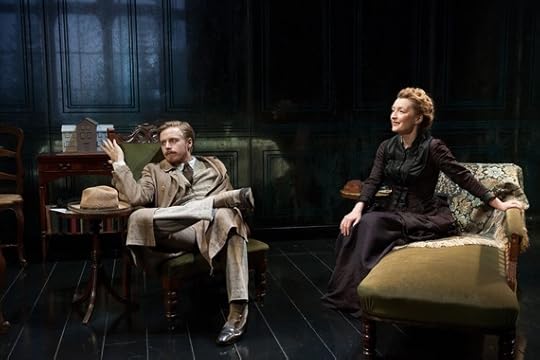
I don't think you could ever witness a better version of Henrik Ibsen's Ghosts than this Richard Eyre-helmed production at the Trafalgar Studios. Genuinely moving but never melodramatic or overwrought, this story of a family trying to escape the ghosts of their past is an exceptional piece of theatre that will resonate long after the curtain falls.
Helene Alving's (Lesley Manville) plans are going as she'd hoped. It is the evening before the tenth anniversary of her husband's death and her son Oswald (Jack Lowden) has returned from Paris to support her as she opens an orphanage in memorial to her husband. And she's not the only one thrilled at her son's return - so is her young maid Regina (Charlene McKenna).
Helene is a modern woman. Since her husband's death she has run her household and managed its finances. She reads feminist literature and supports her son's decision to lead the bohemian life of an artist in Paris. But like everything in this small world of Ibsen's creation, honesty, truth and valour are only skin deep.
As she confesses to her Pastor (Adam Kotz), she has planned to tell her son the truth about his father and the kind of man he actually was. But in one night, events tumble out of control and the ghosts of the past unravel all the secrets and lies that these characters have kept buried deep down.
After a highly acclaimed - and sold out - run at Almedia Theatre in 2013, this harrowing tale of the corrosive effects of living lies and harbouring secrets transfers to the West End. And it is a most welcome transfer.
Richard Eyre, former Director of the National Theatre, is one of this country's finest directors and in his hands this Ibsen, which could be heavy and maudlin, is eminently watchable, with moments of humour that ensure the pangs of despair are all the more profound.
The acting on show is of the highest calibre but it's Lesley Manville in the lead role that breaks your heart. She gives a truly extraordinary performance as a spirited woman undone by the ghosts of the lies that have engulfed her house and her family. It's a performance that moved me to tears.
Lesley Manville's portrayal is of such a standard that it was the source of much controversy last year. At the Evening Standards theatre awards, Helen Mirren took home the gong for Best Actress for The Queen - a result which raised eyebrows from members of the judging panel who had expected Lesley Manville to get the nod.
Both were exceptional performances but Helen Mirren is a household name and her role received much publicity. In contrast Lesley Manville isn't but deserves to be. With this in mind, I urge you to take the opportunity to see this performance and this show before it finishes in March. An Ibsen play may not initially strike you as a good night out but this is a harrowing, poignant piece that reaches deep into your heart and soul.
Trafalgar Studios, London
To March 8, 2014
Published on January 18, 2014 10:11
January 16, 2014
Oh Lena, I Wish You'd Have Said No to Vogue
So it's official. Lena Dunham is the cover girl for the February issue of American Vogue. But much as I love the woman, I really wish she'd turned the offer down.
When it comes to female self-esteem and body image, Vogue is unequivocally part of the problem and not part of the solution. It is the gold standard in an industry that wilfully damages self-esteem to cultivate a dependent market. By being their cover girl, Lena is not just lending them her credibility but also a tacit approval of their methods and behaviour.
For someone who speaks so openly about positive body image, Lena's decision to become Vogue's cover girl is both extraordinary and worrying. As Beyoncé sings rather scathingly in Pretty Hurts, the powerful anti-beauty industry anthem from her latest hit album, "Vogue says, 'thinner is better.'" (I'd love to see Beyoncé back that up with abstaining from any of its covers. We shall see...). But anyway, it's that powerful unbreakable link that exists between Vogue's obsession with being thin and how that impacts women it wants to profit from that should concern us.
The truth is, if Lena weren't famous, a most definitely hot property celebrity, there is no way her looks would be welcome in Vogue. But now that she is famous with an army of admiring women, Vogue has jumped on her, desperate to get cool by association.
That exchange is not two way. Lena is getting nothing out of doing Vogue. She was cool because she wasn't the type of woman you see on the pages of beauty magazines. Women love her because she's real, because she speaks to them, and because they can relate to her.
And it's not as if Lena Dunham needs the coverage. This is a woman who has already won two Golden Globes for her hit series Girls. This is a woman who is judged for her content, for her intelligence, for her talent - and has come out on top.
In fact it's hard to fathom what Lena gets out of doing Vogue at all. If she thinks that she is somehow helping Vogue to evolve, to change, to embrace women who don't look like models, she is very much mistaken. Vogue is simply appropriating her credibility. Her cover is a token gesture, a superficial offering in exchanging for all of the cool Lena lends to it.
It is also a way of harvesting new readers, young women who love Lena but are not Vogue readers. And that's where it begins. Vogue charms these young women to their pages. Then when their celebrities disappear, all that's left are the impossible beauties of the modelling world. And so the cycle of self-loathing and dream body image begins for all those readers that picked up the magazine because it had Lena on the cover.
Vogue is not averse to harvesting celebrities for its covers and using them for their own benefit. Katy Perry was on the cover of the magazine last year and even though she was already thin, she was honest about the lengths she went to to get "glowing for that cover."
Oprah went on the cover of Vogue in 1998 and was famously 'asked' by Anna Wintour to shed 20 pounds for the privilege. Incredibly Oprah agreed. Why she let Anna Wintour diminish her like that I'll probably never know. But this is the power of Vogue. If media's most powerful person kowtows to the body fascism of Anna Wintour, what does that say about the emancipation of women?
Anyway Oprah shed the weight, did the (airbrushed) cover then promptly put the weight back on. And the pages of Vogue were not filled with plus-size models and 'real women' afterwards. No. Vogue simply returned to the double zero dress size diktat it has had for so long.
Now I appreciate that Lena has done magazine interviews before and that the accompanying photos were also photo-shopped, but Vogue is different. It doesn't follow fashion, it leads it. And not only that, its editor is the most powerful person in fashion. We still live in a world where to be invited to be a cover girl for it is a dream come true (just look at how hard Victoria Beckham and Kim Kardashian lobby for the honour). We should want more for ourselves than this.
Female self-esteem cannot begin to improve until Vogue becomes irrelevant. By agreeing to be their cover girl, Lena has just delayed that day of reckoning. I wish she had told Anna Wintour to shove it. Whoever does becomes my hero.
When it comes to female self-esteem and body image, Vogue is unequivocally part of the problem and not part of the solution. It is the gold standard in an industry that wilfully damages self-esteem to cultivate a dependent market. By being their cover girl, Lena is not just lending them her credibility but also a tacit approval of their methods and behaviour.
For someone who speaks so openly about positive body image, Lena's decision to become Vogue's cover girl is both extraordinary and worrying. As Beyoncé sings rather scathingly in Pretty Hurts, the powerful anti-beauty industry anthem from her latest hit album, "Vogue says, 'thinner is better.'" (I'd love to see Beyoncé back that up with abstaining from any of its covers. We shall see...). But anyway, it's that powerful unbreakable link that exists between Vogue's obsession with being thin and how that impacts women it wants to profit from that should concern us.
The truth is, if Lena weren't famous, a most definitely hot property celebrity, there is no way her looks would be welcome in Vogue. But now that she is famous with an army of admiring women, Vogue has jumped on her, desperate to get cool by association.
That exchange is not two way. Lena is getting nothing out of doing Vogue. She was cool because she wasn't the type of woman you see on the pages of beauty magazines. Women love her because she's real, because she speaks to them, and because they can relate to her.
And it's not as if Lena Dunham needs the coverage. This is a woman who has already won two Golden Globes for her hit series Girls. This is a woman who is judged for her content, for her intelligence, for her talent - and has come out on top.
In fact it's hard to fathom what Lena gets out of doing Vogue at all. If she thinks that she is somehow helping Vogue to evolve, to change, to embrace women who don't look like models, she is very much mistaken. Vogue is simply appropriating her credibility. Her cover is a token gesture, a superficial offering in exchanging for all of the cool Lena lends to it.
It is also a way of harvesting new readers, young women who love Lena but are not Vogue readers. And that's where it begins. Vogue charms these young women to their pages. Then when their celebrities disappear, all that's left are the impossible beauties of the modelling world. And so the cycle of self-loathing and dream body image begins for all those readers that picked up the magazine because it had Lena on the cover.
Vogue is not averse to harvesting celebrities for its covers and using them for their own benefit. Katy Perry was on the cover of the magazine last year and even though she was already thin, she was honest about the lengths she went to to get "glowing for that cover."
Oprah went on the cover of Vogue in 1998 and was famously 'asked' by Anna Wintour to shed 20 pounds for the privilege. Incredibly Oprah agreed. Why she let Anna Wintour diminish her like that I'll probably never know. But this is the power of Vogue. If media's most powerful person kowtows to the body fascism of Anna Wintour, what does that say about the emancipation of women?
Anyway Oprah shed the weight, did the (airbrushed) cover then promptly put the weight back on. And the pages of Vogue were not filled with plus-size models and 'real women' afterwards. No. Vogue simply returned to the double zero dress size diktat it has had for so long.
Now I appreciate that Lena has done magazine interviews before and that the accompanying photos were also photo-shopped, but Vogue is different. It doesn't follow fashion, it leads it. And not only that, its editor is the most powerful person in fashion. We still live in a world where to be invited to be a cover girl for it is a dream come true (just look at how hard Victoria Beckham and Kim Kardashian lobby for the honour). We should want more for ourselves than this.
Female self-esteem cannot begin to improve until Vogue becomes irrelevant. By agreeing to be their cover girl, Lena has just delayed that day of reckoning. I wish she had told Anna Wintour to shove it. Whoever does becomes my hero.
Published on January 16, 2014 16:00
What Next for Lady Gaga?
2013 was not kind to Gaga. ARTPOP didn't sell, Beyoncé stole her thunder and her management fell into disarray. Is this a temporary blip or the start of a longer term malaise?
ARTPOP, Gaga's third album (or fourth, depending on whether you split The Fame from Monster) was supposed to be a momentous event. It wasn't. But boy did Gaga and her team try hard to make it one. The PR push was relentless from the international tour to promote the album, the leaked tracks, the hype on the unveiling of the album cover... and it didn't pay off.
Now I love Gaga but there's no escaping the cold hard truth - the songs on ARTPOP were distinctly average. The lead single Applause was catchy enough but the album was not packed with hits - unlike her previous albums.
The exception of course is Do What U Want, arguably a better track than Applause. But there is one massive problem with it - R Kelly. Quite what possessed Gaga to approve that collaboration is beyond me but the social media backlash should have been expected.
And whether it was Gaga's decision or not to pick R Kelly she didn't back down when the controversy hit. As she breathlessly remarked on The X Factor UK after her rather headline-baiting performance, "I love R Kelly." Well you're on your own there.
Maybe her management did get it because suddenly the accompanying video, rumoured to have been shot by Terry Richardson, another sex pest, was delayed. It still hasn't been released. One sex pest is careless, two is appallingly poor judgment, especially from someone who prides herself on her love for others.
Do What U Want is probably the best song on the album but it's unlikely the video will ever be seen. Certainly its arrival now would be too late to save sales. That single has long fallen out of charts. Not even the rushed release of a new version with Christina Aguilera could resuscitate it.
That doesn't leave much on ARTPOP to exploit Sexxx Dreams, MANiCURE and Mary Jane Holland may be interesting but they're not singles with the same catchy, anthemic brilliance of Bad Romance, Poker Face, Telephone, Marry the Night, The Edge of Glory etc. etc, the tracks that dominated Gaga's previous albums.
An attempt was made with Venus but though the chorus is superb, the verses are a bit nuts and again, there was no video ready which left Gaga at the mercy of radio airplay and Venus didn't catch fire.
Worse was to follow for a woman who clearly wants to be the biggest pop star on the planet when Beyoncé caught everyone by surprise with the sudden drop of her eponymous album in December.
With sales of 1.5million in a matter of weeks, Beyoncé smashed all other female artists out of the water in 2013. But also Beyoncé's concept of having a video for every track exploited a massive flaw in ARTPOP. It was a trick missed as surely a visual representation for every song should be more at home with Gaga and an album that claims "Pop culture was in art; now art's in pop culture in me."
I suspect Gaga too realises that now, which may be fermenting her distress. And now that Beyoncé's done it, anyone who does the same will be accused of copying.
It doesn't help Gaga that she is hyper-sensitive to any criticism. Though it's never nice it is a part of the territory. And she doesn't help her case when she blames everyone else.
She fired her whole management team, replacing them with her father who is reputed to be getting a whopping 50% of Gaga's earnings as compensation - an amount so eye-watering it'll have Britney's guardians thinking they're underpaid.
But though Gaga's having a tough time of it - critically and commercially - she really shouldn't beat herself up.
Gaga now goes on tour. May 2014 sees the kick-off of her Artrave: The Artpop Ball tour. Ideally the tour would replenish her coffers - after all touring is now far more profitable than record sales - and her previous tour, Born This Way, was one of the most lucrative tours in history. Live, Gaga is still phenomenal and always show why she remains the most exciting popstar on the planet - all others dull in comparison.
We shouldn't forget that Gaga is still relatively young, even in pop terms. At 27 years old she is still younger than Beyoncé (32), Britney (32) and Katy Perry (29). And though ARTPOP might not have excited, 500,000 copies are the kind of sales figures most other artists can only dream of. Yes, Beyoncé sold this in two days and overall ARTPOP has been outsold by Katy Perry's Prism (1 million copies) and Miley Cyrus Bangerz (800,000 copies) but its sales figures are still good.
The worst thing would be for Gaga to let the relative underperformance of ARTPOP affect her adversely. She has got to focus on the long-game here. All big stars have career highs and lows.
Creatively I love Gaga, she's a risk-taker. But she does need to accept that risk-taking doesn't always equal sales. The two do not go hand in hand. I wish she would let go of chasing sales-based achievements and focus on her creative output, on delivering material that reflects who she is, irrelevant of critical and commercial success.
That of course is how Beyoncé turned herself around - by letting go of her perceived need to generate music for her fans and of the pressure to be No. 1. Simply put, Gaga needs to stop trying so hard. She has enough talent to ensure that the rest will take care of itself.
ARTPOP, Gaga's third album (or fourth, depending on whether you split The Fame from Monster) was supposed to be a momentous event. It wasn't. But boy did Gaga and her team try hard to make it one. The PR push was relentless from the international tour to promote the album, the leaked tracks, the hype on the unveiling of the album cover... and it didn't pay off.
Now I love Gaga but there's no escaping the cold hard truth - the songs on ARTPOP were distinctly average. The lead single Applause was catchy enough but the album was not packed with hits - unlike her previous albums.
The exception of course is Do What U Want, arguably a better track than Applause. But there is one massive problem with it - R Kelly. Quite what possessed Gaga to approve that collaboration is beyond me but the social media backlash should have been expected.
And whether it was Gaga's decision or not to pick R Kelly she didn't back down when the controversy hit. As she breathlessly remarked on The X Factor UK after her rather headline-baiting performance, "I love R Kelly." Well you're on your own there.
Maybe her management did get it because suddenly the accompanying video, rumoured to have been shot by Terry Richardson, another sex pest, was delayed. It still hasn't been released. One sex pest is careless, two is appallingly poor judgment, especially from someone who prides herself on her love for others.
Do What U Want is probably the best song on the album but it's unlikely the video will ever be seen. Certainly its arrival now would be too late to save sales. That single has long fallen out of charts. Not even the rushed release of a new version with Christina Aguilera could resuscitate it.
That doesn't leave much on ARTPOP to exploit Sexxx Dreams, MANiCURE and Mary Jane Holland may be interesting but they're not singles with the same catchy, anthemic brilliance of Bad Romance, Poker Face, Telephone, Marry the Night, The Edge of Glory etc. etc, the tracks that dominated Gaga's previous albums.
An attempt was made with Venus but though the chorus is superb, the verses are a bit nuts and again, there was no video ready which left Gaga at the mercy of radio airplay and Venus didn't catch fire.
Worse was to follow for a woman who clearly wants to be the biggest pop star on the planet when Beyoncé caught everyone by surprise with the sudden drop of her eponymous album in December.
With sales of 1.5million in a matter of weeks, Beyoncé smashed all other female artists out of the water in 2013. But also Beyoncé's concept of having a video for every track exploited a massive flaw in ARTPOP. It was a trick missed as surely a visual representation for every song should be more at home with Gaga and an album that claims "Pop culture was in art; now art's in pop culture in me."
I suspect Gaga too realises that now, which may be fermenting her distress. And now that Beyoncé's done it, anyone who does the same will be accused of copying.
It doesn't help Gaga that she is hyper-sensitive to any criticism. Though it's never nice it is a part of the territory. And she doesn't help her case when she blames everyone else.
She fired her whole management team, replacing them with her father who is reputed to be getting a whopping 50% of Gaga's earnings as compensation - an amount so eye-watering it'll have Britney's guardians thinking they're underpaid.
But though Gaga's having a tough time of it - critically and commercially - she really shouldn't beat herself up.
Gaga now goes on tour. May 2014 sees the kick-off of her Artrave: The Artpop Ball tour. Ideally the tour would replenish her coffers - after all touring is now far more profitable than record sales - and her previous tour, Born This Way, was one of the most lucrative tours in history. Live, Gaga is still phenomenal and always show why she remains the most exciting popstar on the planet - all others dull in comparison.
We shouldn't forget that Gaga is still relatively young, even in pop terms. At 27 years old she is still younger than Beyoncé (32), Britney (32) and Katy Perry (29). And though ARTPOP might not have excited, 500,000 copies are the kind of sales figures most other artists can only dream of. Yes, Beyoncé sold this in two days and overall ARTPOP has been outsold by Katy Perry's Prism (1 million copies) and Miley Cyrus Bangerz (800,000 copies) but its sales figures are still good.
The worst thing would be for Gaga to let the relative underperformance of ARTPOP affect her adversely. She has got to focus on the long-game here. All big stars have career highs and lows.
Creatively I love Gaga, she's a risk-taker. But she does need to accept that risk-taking doesn't always equal sales. The two do not go hand in hand. I wish she would let go of chasing sales-based achievements and focus on her creative output, on delivering material that reflects who she is, irrelevant of critical and commercial success.
That of course is how Beyoncé turned herself around - by letting go of her perceived need to generate music for her fans and of the pressure to be No. 1. Simply put, Gaga needs to stop trying so hard. She has enough talent to ensure that the rest will take care of itself.
Published on January 16, 2014 15:16
January 15, 2014
Manon, Royal Opera House - Opera Review
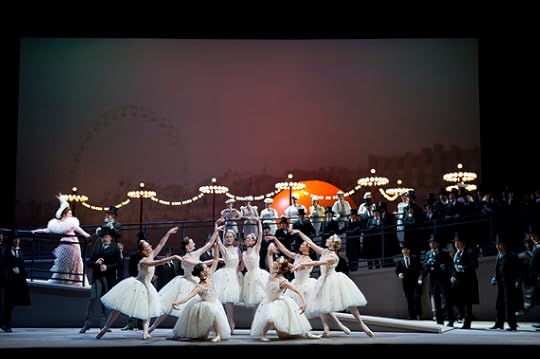
Massenet's most famous opera, a moralistic story of love versus materialism, should be full of wit, passion and drama but this production at the Royal Opera House, whilst enjoyable, could do with more innovation and creativity.
Manon (Ermonela Joho) is a very beautiful young woman on her way to the convent. But as she waits for the coach in the unfamiliar town of Amiens, she meets des Grieux (Matthew Polenzani) and the two instantly fall head over heels in love, as can happen at bus stops.
Overwhelmed with passion, the two immediately flee to Paris. But Manon's cousin Lescaut and her legion of admirers do not give her up so easily. She is tracked down by Lescaut (Audun Iversen) and her suitor de Bretigny (William Shimell) and forced to come to her senses.
Persuaded that the impoverished des Grieux cannot give her a future, Manon leaves with the wealthy de Bretigny. Broken by his abandonment, des Grieux devotes his life to God, as tends to happen in opera. But Manon soon realises that riches and furs cannot replace true love and so she sets out to track her former lover down and win him back. But obviously, this being an opera, I can't say this endeavour ends well for Manon.
Joho gives a strong performance as the complex Manon. Certainly her voice shines - she has great strength throughout her range and there was real emotional depth in the more dramatic arias. It was also a competent acting performance, though Joho seemed more at ease with Manon's guilt and passion rather than her girlish playfulness.
Polenzani also has a great voice but the production is largely stolen by Christophe Mortagne in the role of Guillot, one of Manon's many wealthy admirers. His comic timing and characterisation (as well as phenomenal voice) keeps his character on the right side away from being a rather unlikeable dirty old man.
This production initially premiered in 2010 and is competently directed by Laurent Pelly who makes good use of the available resources, though there is little about the production that is inventive.
The main characters are supported by a vast chorus of men and women who bustle around the sets. Whether they're travellers battling for their luggage at the bus stops or the party-goers at the festival of Cours-la-Reine, they bring great atmosphere and energy to the scenes.
There are also a few nods to popular culture. This is a tale of a young woman looking for love but distracted by wealth - not an unfamiliar tale. In Act Three Manon is at the promenade of Cours-la-Reine. Now partnered with de Bretigny, she has all the fine dresses and jewels she could want. Surrounded by a bevy of men in their top hat and tails, she playfully sings and teases them all whilst dressed in a long pink dress, gloves and diamond necklace - very much the Marilyn moment in the show.
Massenet certainly went all out in this opera, incorporating as much as he could get away with. In Act Three, Guillot drags in the Parisian Opera's corps de ballet to perform as part of his charm offensive against Manon, indulging Massenet's ability to compose as well for ballet as for opera. And certainly this cross-population of art forms was well-received as dancers from the Royal Ballet came onstage to perform.
The orchestra was conducted by Emmanuel Villaume, who brought a wonderfully deft touch to the vast range of emotions within the music. Unlike other operas, Manon lacks a memorable big number but nevertheless the orchestral performance was superb.
The set design for this production was created some years ago and not only does it seem dated when compared to other set designs such as the ground-breaking Minghella-directed Madam Butterfly, but parts of it are also beginning to look a bit worn.
Act One sees the packed streets of Amiens represented nicely with a design of rooftops and plenty of windows for the ensemble to poke their heads out of, but the material used looks like stiff cardboard. Hardly appealing.
And in Act Two, the run-down top-floor apartment in Paris that the lovers have absconded to is built on a free-standing raised platform. But this was looking far from robust. It was actually swaying during the scene, which must have been pretty scary for the performers.
The set wasn't the only element showing its age. In Act Three, after the wonderful ballet interlude, the crowd of drunken men launch themselves at the ballerinas, bundling them over their shoulders. I suspect this was meant as a comic moment but it was greeted in stony silence by the auditorium. Scenes of women being dragged away by drunken men against their will have long stopped being funny.
These concerns aside, I did enjoy the production and despite its length, the audience was fully engaged throughout the four hour running time. However this is the Royal Opera House and it should look to start updating some of these staid productions and be more willing to challenge itself.
Royal Opera House, London
To February 4, 2014
Picture credits: © ROH/ BILL COOPER
Published on January 15, 2014 11:28
January 14, 2014
Not I, Footfalls, Rockaby (Beckett Trilogy), Royal Court - Review
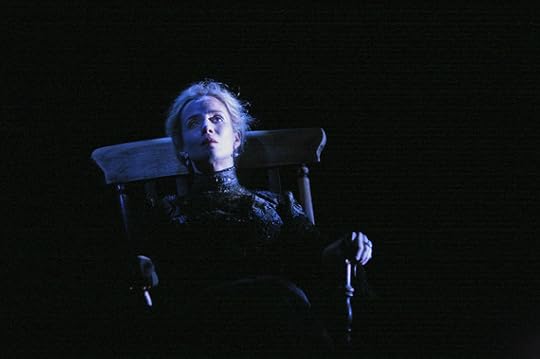
The Royal Court starts 2014 with a very daring Samuel Beckett one-woman show. Whether this risk pays off is questionable but the boldness of the decision is admirable.
The Not I/Footfalls/Rockaby triple bill gets off to a pacey start with Not I. The theatre is plunged into darkness and all that can be seen is a disembodied mouth floating in the air, much like the Cheshire Cat's grin. What follows is a monologue so fast, so sprawling in its delivery and content that it is hard to follow what's being said. Which is the point.
The monologue mimics the fascinating and the banal information in a stream of conscious thought. Lisa Dwan's rapid, fluent delivery is extraordinary. Her flow is so fast and articulate, funny and dramatic, it'd make Eminem jealous. But after this snappy, spirited first act, the rest of the production takes on a densely sombre tone.
Footfalls is a melancholic tale of the burden of responsibility. The woman, May, drags her feet up and down in the shadows of a darkened room. Her sick mother an ever-present burden and ever-constant thought in her mind. Unable to leave, May waits to be beckoned forward to straighten the pillows or moisten the lips of her ill mother. Her past and her future all forgotten. All that exists is the here and now, and the weight of her never-ending duties.
The heavy depressed tone continues in the third piece, Rockaby. In this, a lonely woman, old before her time, sits in a rocking chair. The chair rocks back and forth in perpetual motion as the woman winds down through the last few moments of her life.
Overall, the pieces are intellectually stimulating and occasionally moving but my mind wandered too much to say they are absorbing. I know that given this is Samuel Beckett the plays are not going to have people rolling in the aisles but there is plenty of black humour in his work and perhaps more of that could have been developed to help break up the heavy depressive tone. By doing so, it might also have prevented the short running time of 50 minutes from dragging in places.
But that's not to say there isn't anything rewarding about this production.
Lisa Dwan is superb. Her versatility in delivery and tone across the three pieces, giving each character a distinctive voice, is first-class.
Walter Asmus' direction is also excellent. With such limited text, the assumption can be that this stuff is easy to direct, that it sort of throws itself together. Not at all. That great thought has gone into the design and direction is clear. Though the tone might be heavy for me, once that creative choice was made, that atmosphere is delivered all the way through with very emotive use of light and shadow, and a very sparse set.
I can't decide whether it was brave or foolish of the Royal Court to use its main stage for this very experimental production. Instinct suggests that the Jerwood Theatre Upstairs would be a more natural home for this short one-woman show. So I applaud them for taking the risk but given that tickets are up to £25, I'd be more inclined to recommend it if it were upstairs and cheaper.
The short run for this Beckett trilogy at the Royal Court is sold out but you can call the Box Office to try your luck for returns or day tickets. Alternatively a better bet might be to go when the production transfers to the Duchess Theatre in the West End in February and then on a subsequent national tour.
Royal Court Theatre, London
To January 18, 2014
Published on January 14, 2014 14:33
January 12, 2014
Film Review: 12 Years a Slave
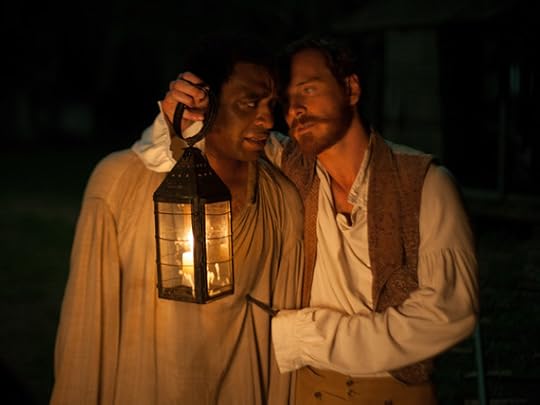
Few films will impact you like 12 Years a Slave. It's brutal, tragic and an unflinching account of slavery. But such is the talent through every aspect of this production that the film is also gripping and eminently watchable.
The film is based on the true story of Solomon Northup (Chiwetel Ejiofor), a free black man from New York who is drugged by two white men who make his acquaintance and sold into slavery. Unable to contact his wife and children and broken by the violence of his captivity, he is smuggled into the South where he is sold to slave owner William Ford (Benedict Cumberbatch).
Ford is a comparably compassionate man but also a weak one. He recognises Northup's skills and rewards him with token acts of kindness but lacks the courage to act on his doubts when Northup confesses to him that he is a free man. Instead of freeing Northup, he passes him on to vicious and sadistic slave master Edwin Epps (Michael Fassbender) to settle a debt. And what started off as a gross act of injustice suddenly gets a whole lot worse.
The story is terrible and fascinating as is but in Steve McQueen's hands, the film has its perfect helmsman. Nothing is spared and nothing is glorified. A life in slavery was bloody, brutal and often short. None of that is glossed over here. But the politics of life as a slave was also complex.
Survival for slaves meant that it was wiser for them not to get involved, not to intervene when other slaves were brutalised, raped or even strung up. The guilt of that complicity of silence weighs heavy in the film.
A sequence where Solomon has only barely survived being strung up by a vitriolic overseer but is left in his noose, hands tied behind his back, with only the tips of his toes touching the ground being all that stands between him and a broken neck is traumatising. Solomon is left there all day whilst the other slaves pass by, none daring to cut him down to save him.
McQueen is also not afraid from showing how other black men and women became active participants in the perpetuation of slavery by working up to whip-hands as willing and vicious as the white men they've replaced. And those black women who've caught the eye of their white male slave owners and moved up from slave to lady of the house take on the airs and graces of the white society that oppressed them, doing nothing to ease the pain for those they left behind.
This silence is literal too. There is almost not a single note of musical accompaniment in the film. The cotton-picking is in silence, what passes as dinner is eaten in silence and the slaves' long nights in bare, cold rooms are endured in silence.
The acting is extraordinary from every actor in the cast, whether in a significant role or part of the ensemble.
Once bound in chains, Solomon Northup has almost nothing to say. Of course he doesn't. He is a slave and slaves are not allowed to speak. And such is the fear, they don't even talk amongst themselves when their masters backs are turned. Instead Chiwetel Ejiofor shows Solomon's agony and his bitter guilt at his complicity in the keep-your-heads-down mentality through the occasional glance up and the increasing hunch in his shoulders.
Brad Pitt and Benedict Cumberbatch both give brief but perfectly pitched performances as men who recognise the injustice of slavery but with different strengths of character in addressing their doubts.
Lupita Nyong'o is a revelation as Patsey, the young slave who is the subject of an obsessive, possessive fixation from Epps. And Sarah Paulson who plays his jealous wife, Mary, is superb.
And Fassbender is awesome as the sick sadistic slave master whose vicious treatment of his property is matched only by his lust for Patsey. His mere presence cows everyone on his plantation into silence whilst even a deeply whispered threat from him into the ear is enough to terrorise even the most hardened man. It is a performance that underlines what a brilliant actor he is.
I came out of the film heartbroken. There was no joy in Solomon's eventual reconciliation with the family - nor does the film look to foster such sentiment. Far too much damage has been done to the mind, body and soul for there to be any smiles at the end.
I have a weakness for films that scar the soul and 12 Years a Slave scars very deep indeed. Beautiful. Harrowing. Unforgettable.
Published on January 12, 2014 13:58



